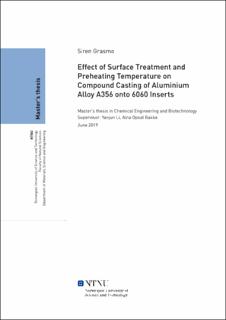| dc.contributor.advisor | Li, Yanjun | |
| dc.contributor.advisor | Bakke, Aina Opsal | |
| dc.contributor.author | Grasmo, Siren | |
| dc.date.accessioned | 2019-10-25T14:00:27Z | |
| dc.date.issued | 2019 | |
| dc.identifier | no.ntnu:inspera:40490679:34320513 | |
| dc.identifier.uri | http://hdl.handle.net/11250/2624521 | |
| dc.description.abstract | For bilindustrien er det viktig å studere ulike metoder for å redusere kjøretøyvekt, da dette reduserer bensinforbruk, noe som vil ha både økonomiske og miljømessige fordeler.
Hybridstøpning er å støpe et flytende materiale på en fast overflate. Ved å støpe et lettvektig metall på en sterkere komponent, kan kravene til styrke bli overholdt, samtidig som den samlede vekten blir redusert. Aluminium er et velegnet metall for bildeler, men det naturlige oksidlaget på overflaten er en utfordring ved hybridstøping. Overflatefukting av aluminium på Al2O3 er dårlig, og diffunderingen hindres av oksidlaget.
I denne studien ble aluminiumlegeringen A356 forsøkt faststøpt på en innsats av 6060 ved hybridstøping. I tre separate eksperimenter ble effekten av sinkbehandling på innsatsene samt forvarming av innsatsene og formen studert. Eksperiment 1 testet om sinkbehandling ville føre til sammenføyning. Eksperiment 2 undersøkte effekten av forvarming av enten innsatsen eller formen på sprekkdannelsen mellom innsatsen og støpelegeringen. Eksperiment 3 studerte om høy forvarming av innsats of form kunne resultere i sammenføyninig. Innsatser formet som både staver og rør ble brukt. Alle prøvene ble studert gjennom et skanningelektronmikroskop, og simulering av spenningsfelt i prøvene ble utført med programvaren StaMiSim.
I det første eksperiment ble fylling av støpeform og størkning simulert i SutCast før støpning for å fastsette formvarmingstemperaturene. Ulike metoder for påføring av sinklaget ble brukt for å få ulike tykkelser. Sinklaget hadde ikke god nok kvalitet til å forhindre reokidering av aluminiumsoverflaten. Sinken ble funnet som et diffusjonslag i 6060 ved EDS-analyse, og sammenføyning ble ikke oppnådd. Påføringsmetoden må forbedres for å kunne studere effekten av tykkelsen til sinklaget.
I det andre eksperimentet ble det variert om innsatsen eller støpeformen ble forvarmet. Den ene ble holdt på romtemperatur mens den andre ble forvarmet til 600° C. Den planlagte temperaturforskjellen ble redusert pga. varmeoverføring da innsatsen ble plassert i formen. Områder med mulig smelting av innsatsoverflaten og sprekker langs grensesjiktet ble observert i begge seriene.
Det tredje eksperimentet ble utført med høye forvarmingstemperaturer og med staver eller rør som innsatser. Selv uten overflatebehandling ble suksessfull binding oppnådd på innsiden av rørene. Langs stavene og utsiden av rørene ble det dannet sprekker langs grensesjiktene eller gjennom den eutektisk silisiumen i A356. Dette resulterte i en svak hybridstøpt del, til tross for at binding mellom A356 og 6060 ble oppnådd. | |
| dc.description.abstract | Reduction of vehicle weight is an important field of study for the automotive industry, as this would decrease fuel consumption and result in both economic and environmental benefits.
Compound casting is the casting of a liquid material onto a solid structure of another. By casting a light-metal onto a stronger structure, the required strength of a component could be achieved while reducing the overall weight. Aluminium is a well-suited metal used in the automotive industry, but the natural oxide layer is a challenge during compound casting. Wettability of aluminium on Al2O3 is poor, and the formation of a reaction zone between the insert and cast aluminium is inhibited by the oxide layer.
In this thesis, the aluminium alloys A356 and 6060 were joined through a compound casting process. The effects of preheating temperatures and zincate treatment on the inserts were studied separately in three experiments. Experiment 1 tested if bonding could be achieved with zinc coated inserts. Experiment 2 studied the effect of preheating either the insert or mould on the formation of gaps between the insert and cast aluminium. Experiment 3 tested whether high preheating temperatures for the insert and mould could result in bonding. Both pipes and rods used as inserts. The interface structure of all the compound casting samples were characterised by study in a scanning electron microscope. Stress simulations for the compound cast parts were performed with the software StaMiSim.
In the first experiment, mould filling and solidification was simulated in SutCast to decide preheating temperatures prior to casting. A zinc layer was applied to the inserts by different coating procedures to get different thicknesses. The quality of the zinc layer was not high enough to prevent reoxidation of the aluminium surface. Zinc was detected as a diffusion layer in 6060 by EDS analysis, and bonding was not achieved. The application process of the zinc layer should be further improved before the effect of the thickness can be studied.
For the second experiment, preheating was done for either the insert or mould. One was kept at room temperature, while the other was preheated to 600°C. The intended temperature difference was reduced due to heat transfer as the insert was placed inside the mould. Similar areas of possible melting of the insert surface and cracks along the interface was observed in both series.
The third experiment was performed at high preheating temperatures, with rods or pipes as inserts. Despite no surface treatment of the inserts, successful bonding was achieved on the inside of the pipes. Along the rods and outside of the pipes, cracks formed along the interface or through eutectic silicon in the cast aluminium. This resulted in weak compound cast parts, despite bonding between A356 and 6060 being achieved. | |
| dc.language | eng | |
| dc.publisher | NTNU | |
| dc.title | Effect of Surface Treatment and Preheating Temperature on Compound Casting of Aluminium Alloy A356 onto 6060 Inserts | |
| dc.type | Master thesis | |
